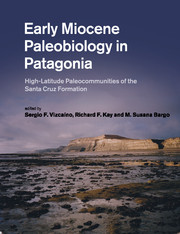Book contents
- Early Miocene Paleobiology in Patagonia
- Frontispiece
- Early Miocene Paleobiology in Patagonia
- Copyright page
- Contents
- Contributors
- Preface
- 1 Background for a paleoecological study of the Santa Cruz Formation (late Early Miocene) on the Atlantic Coast of Patagonia
- 2 Tephrochronology of the Miocene Santa Cruz and Pinturas Formations, Argentina
- 3 Absolute and relative ages of fossil localities in the Santa Cruz and Pinturas Formations
- 4 Sedimentology and paleoenvironment of the Santa Cruz Formation
- 5 Oysters from the base of the Santa Cruz Formation (late Early Miocene) of Patagonia
- 6 Ichnology of distal overbank deposits of the Santa Cruz Formation (late Early Miocene): paleohydrologic and paleoclimatic significance
- 7 Fossil plant studies from late Early Miocene of the Santa Cruz Formation: paleoecology and paleoclimatology at the passive margin of Patagonia, Argentina
- 8 Amphibians and squamate reptiles from the Santa Cruz Formation (late Early Miocene), Santa Cruz Province, Argentina: paleoenvironmental and paleobiological considerations
- 9 Diversity and paleobiology of the Santacrucian birds
- 10 Paleoecology of the Paucituberculata and Microbiotheria (Mammalia, Marsupialia) from the late Early Miocene of Patagonia
- 11 Paleoecology of the mammalian carnivores (Metatheria, Sparassodonta) of the Santa Cruz Formation (late Early Miocene)
- 12 Paleobiology of Santacrucian glyptodonts and armadillos (Xenarthra, Cingulata)
- 13 Paleobiology of the Santacrucian sloths and anteaters (Xenarthra, Pilosa)
- 14 Paleobiology of Santacrucian native ungulates (Meridiungulata: Astrapotheria, Litopterna and Notoungulata)
- 15 Paleobiology of Santacrucian caviomorph rodents: a morphofunctional approach
- 16 Paleobiology of Santacrucian primates
- 17 A review of the paleoenvironment and paleoecology of the Miocene Santa Cruz Formation
- Index
13 - Paleobiology of the Santacrucian sloths and anteaters (Xenarthra, Pilosa)
Published online by Cambridge University Press: 05 June 2013
- Early Miocene Paleobiology in Patagonia
- Frontispiece
- Early Miocene Paleobiology in Patagonia
- Copyright page
- Contents
- Contributors
- Preface
- 1 Background for a paleoecological study of the Santa Cruz Formation (late Early Miocene) on the Atlantic Coast of Patagonia
- 2 Tephrochronology of the Miocene Santa Cruz and Pinturas Formations, Argentina
- 3 Absolute and relative ages of fossil localities in the Santa Cruz and Pinturas Formations
- 4 Sedimentology and paleoenvironment of the Santa Cruz Formation
- 5 Oysters from the base of the Santa Cruz Formation (late Early Miocene) of Patagonia
- 6 Ichnology of distal overbank deposits of the Santa Cruz Formation (late Early Miocene): paleohydrologic and paleoclimatic significance
- 7 Fossil plant studies from late Early Miocene of the Santa Cruz Formation: paleoecology and paleoclimatology at the passive margin of Patagonia, Argentina
- 8 Amphibians and squamate reptiles from the Santa Cruz Formation (late Early Miocene), Santa Cruz Province, Argentina: paleoenvironmental and paleobiological considerations
- 9 Diversity and paleobiology of the Santacrucian birds
- 10 Paleoecology of the Paucituberculata and Microbiotheria (Mammalia, Marsupialia) from the late Early Miocene of Patagonia
- 11 Paleoecology of the mammalian carnivores (Metatheria, Sparassodonta) of the Santa Cruz Formation (late Early Miocene)
- 12 Paleobiology of Santacrucian glyptodonts and armadillos (Xenarthra, Cingulata)
- 13 Paleobiology of the Santacrucian sloths and anteaters (Xenarthra, Pilosa)
- 14 Paleobiology of Santacrucian native ungulates (Meridiungulata: Astrapotheria, Litopterna and Notoungulata)
- 15 Paleobiology of Santacrucian caviomorph rodents: a morphofunctional approach
- 16 Paleobiology of Santacrucian primates
- 17 A review of the paleoenvironment and paleoecology of the Miocene Santa Cruz Formation
- Index
Summary
This chapter reviews the paleobiology of pilosans (anteaters and sloths) from the Santa Cruz Formation, which comprise at least one genus of vermilinguan and 11 genera of sloths. Paleobiological studies performed on these xenarthrans include: estimation of body mass (through multivariate regression); analysis of the limbs so as to infer the locomotor habits and substrate use (through morphometric and qualitative-comparative morphofunctional analyses), and studies of the masticatory apparatus to infer probable feeding habits (mainly through analysis of tooth morphology and wear facets, plus the anatomy of the masticatory apparatus as a whole). Santacrucian anteaters were small animals, about 6 kg, well suited for climbing and for scratch-digging the substrate in searching for their preferred food, social insects. Various sloths were moderately large-sized forms, the largest reaching about 100 kg, with a locomotor pattern distinct from that of living sloths, resembling more that of vermilinguans and pangolins. The results suggest well-developed digging capabilities, but semi-arboreal habits cannot be ruled out. Megatherioid sloths were most likely leaf eaters, and the primary method of food reduction must have been by shearing or cutting (with a predominance of orthal movements). Mylodontid masticatory movements included a larger transverse component, and food reduction must have been by crushing and grinding, which suggests they fed on more compact, three-dimensional, and fibrous food items such as the underground storage organs of plants. The semi-arboreal habits suggested for anteaters and, probably, sloths indicate they lived in forests or that forested areas were present nearby. The specialized feeding habits of vermilinguans are indicative of subtropical and warm temperate environments because they would have depended on a year-round availability of social insects.
- Type
- Chapter
- Information
- Early Miocene Paleobiology in PatagoniaHigh-Latitude Paleocommunities of the Santa Cruz Formation, pp. 216 - 242Publisher: Cambridge University PressPrint publication year: 2012
- 37
- Cited by

